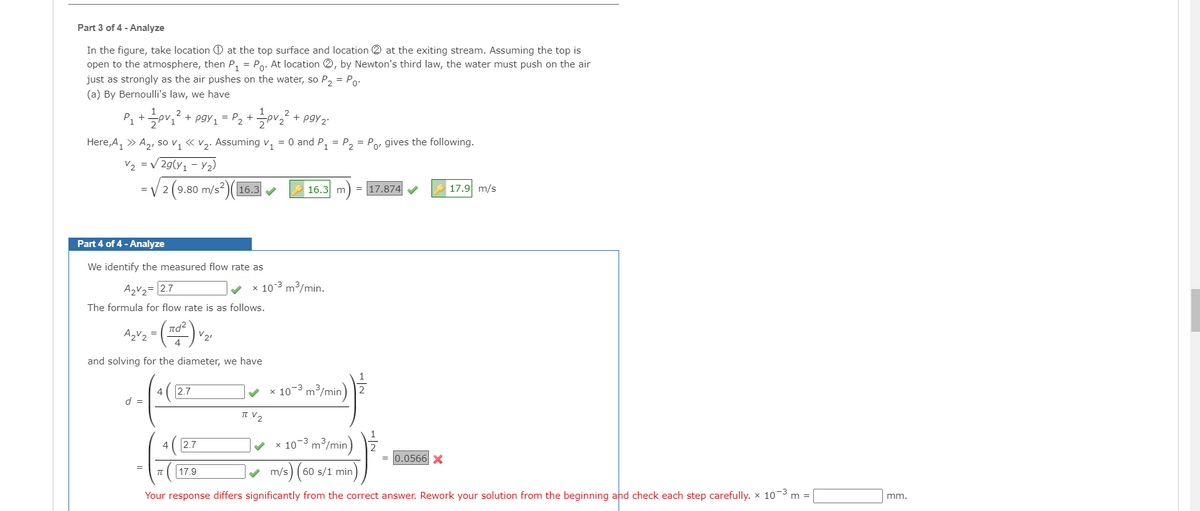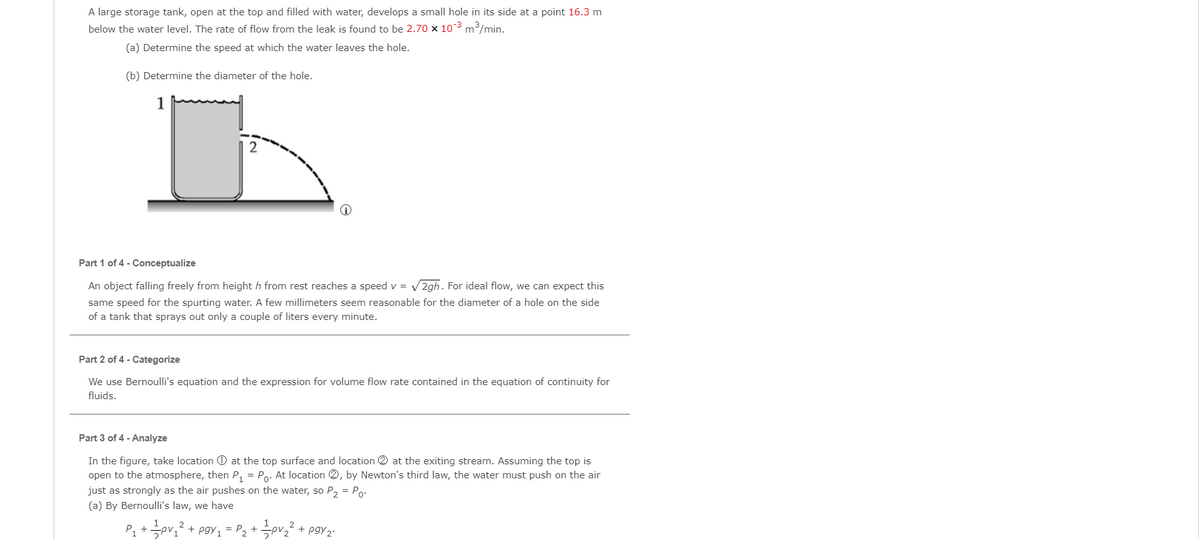Part 3 of 4 - Analyze In the figure, take location O at the top surface and location at the exiting stream. Assuming the top is open to the atmosphere, then P, = Po- At location 0, by Newton's third law, the water must push on the air just as strongly as the air pushes on the water, so P, = Po- (a) By Bernoulli's law, we have Here,A, » Ag, s0 V, « V3. Assuming v, = 0 and P, = P2 = Por gives the following. V2 =v 2g(y, - Y2) 2 (9.80 m/s?)(16.3 16.3 m - 17.874 17.9 m/s Part 4 of 4- Analyze We identify the measured flow rate as AgVz=27 x 10 m/min. The formula for flow rate is as follows. (na² and solving for the diameter, we have 2.7 | × 10-³ m³/min) ( 2.7 v × 10-³ m³/min) -0.0566 X 17.9 m/s) (60 s/1 min Your response differs significantly from the correct answer. Rework your solution from the beginning and check each step carefully. x 103 m = mm.
Part 3 of 4 - Analyze In the figure, take location O at the top surface and location at the exiting stream. Assuming the top is open to the atmosphere, then P, = Po- At location 0, by Newton's third law, the water must push on the air just as strongly as the air pushes on the water, so P, = Po- (a) By Bernoulli's law, we have Here,A, » Ag, s0 V, « V3. Assuming v, = 0 and P, = P2 = Por gives the following. V2 =v 2g(y, - Y2) 2 (9.80 m/s?)(16.3 16.3 m - 17.874 17.9 m/s Part 4 of 4- Analyze We identify the measured flow rate as AgVz=27 x 10 m/min. The formula for flow rate is as follows. (na² and solving for the diameter, we have 2.7 | × 10-³ m³/min) ( 2.7 v × 10-³ m³/min) -0.0566 X 17.9 m/s) (60 s/1 min Your response differs significantly from the correct answer. Rework your solution from the beginning and check each step carefully. x 103 m = mm.
University Physics Volume 1
18th Edition
ISBN:9781938168277
Author:William Moebs, Samuel J. Ling, Jeff Sanny
Publisher:William Moebs, Samuel J. Ling, Jeff Sanny
Chapter14: Fluid Mechanics
Section: Chapter Questions
Problem 84P: Suppose you have a wind speed gauge like the pitot tube shown in Figure 14.32. By what factor must...
Related questions
Question

Transcribed Image Text:Part 3 of 4 - Analyze
In the figure, take location O at the top surface and location 2 at the exiting stream. Assuming the top is
open to the atmosphere, then P, = Po. At location 2, by Newton's third law, the water must push on the air
just as strongly as the air pushes on the water, so P2 = Po-
(a) By Bernoulli's law, we have
P」 + 글pri2+ pgy1= P2 + 극p22 + pgy2
Here, A, » A2, so v, « v2. Assuming v, = 0 and P, = P, = Po, gives the following.
V2 = v 2g(y1 – 2)
=V 2 (9.80 m/s)(
17.9 m/s
16.3
16.3 m
= 17.874
Part 4 of 4 - Analyze
We identify the measured flow rate as
A2V2= [2.7
x 10-3 m3/min.
The formula for flow rate is as follows.
nd?
V21
and solving for the diameter, we have
1
2.7
v x 10-3 m/min)
4
d =
IT V2
2.7
x 10-3 m/min) 2
0.0566 X
m/s) (
60 s/1 min
=
17.9
Your response differs significantly from the correct answer. Rework your solution from the beginning and check each step carefully. x 10-3
m
mm.

Transcribed Image Text:A large storage tank, open at the top and filled with water, develops a small hole in its side at a point 16.3 m
below the water level. The rate of flow from the leak is found to be 2.70 x 103 m3/min.
(a) Determine the speed at which the water leaves the hole.
(b) Determine the diameter of the hole.
1
Part 1 of 4 - Conceptualize
An object falling freely from height h from rest reaches a speed v = V 2gh. For ideal flow, we can expect this
same speed for the spurting water. A few millimeters seem reasonable for the diameter of a hole on the side
of a tank that sprays out only a couple of liters every minute.
Part 2 of 4 - Categorize
We use Bernoulli's equation and the expression for volume flow rate contained in the equation of continuity for
fluids.
Part 3 of 4 - Analyze
In the figure, take location O at the top surface and location 2 at the exiting stream. Assuming the top is
open to the atmosphere, then P, = Po. At location 2, by Newton's third law, the water must push on the air
just as strongly as the air pushes on the water, so P, = Po:
(a) By Bernoulli's law, we have
P, +pv,? + pgy, = P2 + pv² + pgy2:
Expert Solution
This question has been solved!
Explore an expertly crafted, step-by-step solution for a thorough understanding of key concepts.
This is a popular solution!
Trending now
This is a popular solution!
Step by step
Solved in 2 steps

Knowledge Booster
Learn more about
Need a deep-dive on the concept behind this application? Look no further. Learn more about this topic, physics and related others by exploring similar questions and additional content below.Recommended textbooks for you

University Physics Volume 1
Physics
ISBN:
9781938168277
Author:
William Moebs, Samuel J. Ling, Jeff Sanny
Publisher:
OpenStax - Rice University

Principles of Physics: A Calculus-Based Text
Physics
ISBN:
9781133104261
Author:
Raymond A. Serway, John W. Jewett
Publisher:
Cengage Learning

College Physics
Physics
ISBN:
9781938168000
Author:
Paul Peter Urone, Roger Hinrichs
Publisher:
OpenStax College

University Physics Volume 1
Physics
ISBN:
9781938168277
Author:
William Moebs, Samuel J. Ling, Jeff Sanny
Publisher:
OpenStax - Rice University

Principles of Physics: A Calculus-Based Text
Physics
ISBN:
9781133104261
Author:
Raymond A. Serway, John W. Jewett
Publisher:
Cengage Learning

College Physics
Physics
ISBN:
9781938168000
Author:
Paul Peter Urone, Roger Hinrichs
Publisher:
OpenStax College